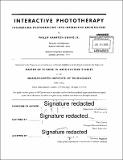Interactive phototherapy : integrating photomedicine into interactive architecture
Author(s)
Ewing, Phillip Hampton, Jr
DownloadFull printable version (10.89Mb)
Alternative title
Integrating photomedicine into interactive architecture
Other Contributors
Massachusetts Institute of Technology. Department of Architecture.
Advisor
Kent Larson.
Terms of use
Metadata
Show full item recordAbstract
This thesis proposes both a physical platform and analytical model for implementing phototherapy in the context of architectural space and dynamic user behavior. By doing so, a number of problems across the fields of (I) healthcare innovation, (2) self-tracking or the "quantified self," and (3) interactive architecture would be solved. First, if healthcare systems are to gain greater insight into a number of conditions that are difficult to diagnose or treat, then passive monitoring and treatment methods must be expanded and improved. Second, if self-tracking devices are to become more accurate in monitoring and informing user health, then more contextual information about user positions and activities with reference to space are needed. Third, if interactive architectural systems are to have continuing relevance, then truly novel applications for augmenting the function of spaces must be explored. The development of a so-called "interactive phototherapy" would provide solutions by (i) increasing patient compliance to phototherapy regimens compared to more conventional methods, (2) improving the accuracy of monitoring information relevant to user health, and (3) expanding the functionality of architectural spaces to novel applications. Interactive phototherapy - a user interaction-oriented approach to phototherapy - is developed in three parts. First, we develop the CityHome, a project of the Changing Places group in the MIT Media Laboratory, as a physical platform capable of meeting technical prerequisites for the implementation of interactive phototherapy. Second, we explain a methodology for analyzing interactive phototherapy that is accessible to architectural designers and related practitioners. Third, we apply this methodology to evaluating hypothetical user interaction scenarios that may occur in the CityHome.
Description
Thesis: S.M., Massachusetts Institute of Technology, Department of Architecture, 2015. Cataloged from PDF version of thesis. Includes bibliographical references (pages 111-117).
Date issued
2015Department
Massachusetts Institute of Technology. Department of ArchitecturePublisher
Massachusetts Institute of Technology
Keywords
Architecture.